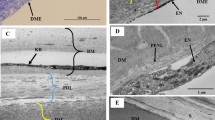Summary
Pieces of rabbit cornea 1–2 mm in breadth and 3–4 mm in length were left in the tissue culture for 2, 4, 7, 10, 16, 20, 24 hours and 2, 5, 10, 14 days; they were then fixed with a buffered 2% OsO4-solution or a 4.2% glutaraldehyde-solution and studied by means of an electron microscope.
The following results were obtained:
-
1.
Almost all the outmost squamoid cells of the normal corneal epithelium develop a cytoplasmic membrane with a specific structure on the surface which is in contact with the tear fluid. The membrane consists of an inner osmiophilic layer approx. 30 Å in breadth, an osmiophobic middle layer approx. 30 Å in breadth and an osmiophilic outer layer which may be up to 100 Å in breadth and from which small scale — like particles constantly break away.
-
2.
This lipid layer forms on the outer osmiophilic layer of the unit-membrane. Membranes in various stages of development from the normal symmetrical unit-membrane to the bounding unit-membrane with the broad lipid layer can be observed.
-
3.
The lipid layer does not reach beyond the zone of contact (nexus-formation) between adjacent squamoid cells. It always ends at the outer edge of the nexus-formation.
-
4.
In the tissue culture the outmost squamoid cells assume globular form and develop tentacular protrusions. During this transformation the lipid layer generally becomes entirely detached from the membrane. The membrane remains intact as a normal unit-membrane.
These findings support our view that the lipid layer protects the outmost squamoid cells against the effect of osmotic pressure in the tear fluid. Since, in the tissue culture medium and cell have approximately the same osmolarity, the protective lipid layer evidently becomes superfluous and is detached from the cell membrane.
Zusammenfassung
1–2 mm breite und 3–4 mm lange Stückchen aus der Kaninchen-cornea wurden 2, 4, 7, 10, 16, 20 und 24 Std sowie 2, 5, 10, und 14 Tage in der Gewebekultur bebrütet, sodann mit einer gepufferten 2% igen OsO4-Lösung oder einer 4,2% igen Glutaraldehyd-Lösung fixiert und elektronenmikroskopisch untersucht. Folgende Befunde wurden erhoben:
-
1.
Fast sämtliche Deckzellen des normalen Epithels haben an der Kontaktfläche mit der Tränenflüssigkeit eine besonders strukturierte Cytomembran. Sie besteht aus einer ca. 30 Å breiten osmiophilen Innenschicht, einer ca. 30 Å breiten osmiophilen Mittelschicht und einer bis 100 Å breiten osmiophilen Außenschicht, von der sich ständig kleine schuppenförmige Gebilde ablösen.
-
2.
Diese Lipoidschicht bildet sich auf der äußeren osmiophilen Schicht der „unit-membrane“. Übergänge von der gewöhnlichen „unit-membrane“ zur Grenzmembrane mit der breiten Lipoidschicht können beobachtet werden.
-
3.
Die Lipoidschicht setzt sich nicht bis in die Haftstellen zwischen benachbarten Deckzellen (Nexus-Formationen) fort, sondern endet stets am äußeren Rand der Nexus-Formation.
-
4.
In der Gewebekultur nehmen die Deckzellen Kugelform an und bilden tentakelartige Fortsätze. Während dieser Umwandlung löst sich die Lipoidschicht im allgemeinen vollständig von der Membran ab. Die Grenzmembran bleibt dabei als normale „unit-membrane“ erhalten.
Die Befunde stützen unsere früher geäußerte Ansicht, daß diese Lipoidschicht die Deckzelle gegen den osmotischen Druck der Tränenflüssigkeit schützt. Da in der Gewebekultur zwischen Medium und Zelle annähernd isotone Bedingungen herrschen, wird diese besondere Schutzvorrichtung offenbar überflüssig und von der Zellmembran abgestoßen.
Similar content being viewed by others
Literatur
Bennett, H. S., and J. H. Luft: s-collidine as a basis for buffering fixatives. J. biophys. biochem. Cytol. 6, 113–114 (1959).
Blümcke, S., and K. Morgenroth jun.: The stereo ultrastructure of the external and internal surface of the cornea. J. Ultrastruct. Res. 18, 502–518 (1967).
Caulfield, J. B.: Effects of varying the vehicle of OsO4 in tissue fixation. J. biophys. biochem. Cytol. 3, 827 (1957).
Ehlers, N.: The precorneal film. Biomicroscopical, histologioal and chemical investigations. Acta ophthal. (Kbh.) Suppl. 81, 1–136 (1965).
Karnovsky, M. J.: Simple methods for “staining with lead“ at high pH in electron microscopy. J. biophys. biochem. Cytol. 11, 729–732 (1961).
Luft, J. H.: Improvements in epoxy resin embedding methods. J. biophys. biochem. Cytol. 9, 409 (1961).
Sabatini, D. D., K. Bensch, and R. J. Barrnett: Cytochemistry and electron microscopy. The preservation of cellular ultrastructure and enzymatic activity by aldehyde fixation. J. Cell Biol. 17, 19–58 (1963).
Trump, B., E. A. Smuckler, and E. P. A. Benditt: A method for staining epoxy sections for light microscopy. J. Ultrastruct. Res. 5, 343 (1961).
Weitere Literatur zur Feinstruktur des Corneaepithels s. bei BlÜmcke und Morgenroth (1967).
Author information
Authors and Affiliations
Additional information
Mit dankenswerter Unterstützung durch die Deutsche Forschungsgemeinschaft.
Rights and permissions
About this article
Cite this article
Blümcke, S., Niedorf, H.R., Rode, J. et al. Feinstrukturelle Veränderungen des Corneaepithels in der Gewebekultur. Z. Zellforsch. 82, 589–603 (1967). https://doi.org/10.1007/BF00337124
Received:
Issue Date:
DOI: https://doi.org/10.1007/BF00337124




